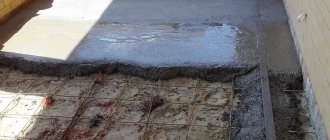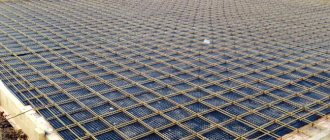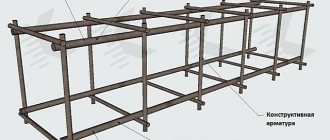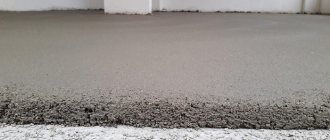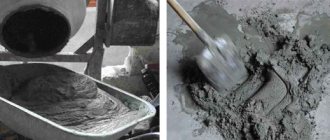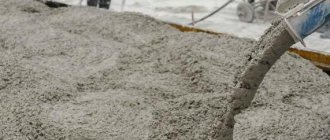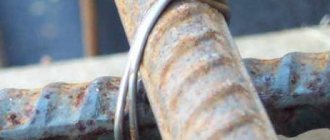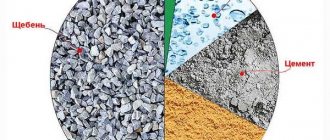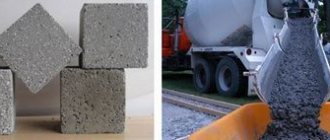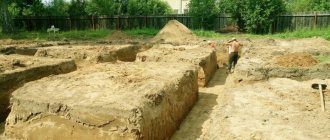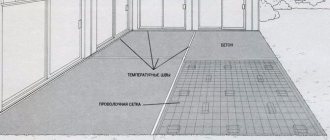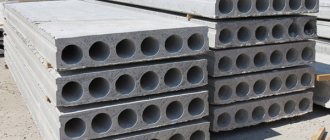Classification of concrete solutions
The composition of concrete includes cement, water, filler and special additives . Crushed stone, sand, gravel and other bulk materials can be used as filler. The additive in the solution serves to reduce internal stress during hardening.
The strength of the finished monolith depends on the amount of water in the mixture. Concrete is classified according to characteristics, which in turn are determined by the ratio of components.
Criteria for assessing the quality of concrete:
M – grade from M100 to M500 . The indicator reflects the performance of the solution.- P – mobility of concrete (from P1 to P5) . For standard slab foundations, concrete with indicators P3 and P4 is chosen.
- B – composition strength from B3.5 to B60 . The value of the indicator is chosen based on the maximum load on the foundation. Guaranteed strength means the load that a monolithic base can withstand in 95% of cases.
- W – indicator of concrete permeability to water (from W2 to W12) . When choosing a solution class, they are guided by the level of groundwater below the supporting base area.
- F – frost resistance from F25 to F1000 . Experts recommend using a class of concrete with a high degree of frost resistance to eliminate the possibility of cracking of the monolith as a result of sudden temperature changes.
Thus, the final quality of concrete depends on a number of different indicators, the optimal characteristics of which are selected based on the design conditions of construction.
Below are the grades of concrete whose characteristics are suitable for the construction of a slab foundation:
| Concrete grade | Strength | Degree of mobility | Frost resistance degree | Waterproof |
| M250 | IN 20 | P4 | F100 | W6 |
| M300 | B22.5 | P4 | F200 | W6-8 |
| M350 | B25 | P4 | F300 | W8 |
| M400 | B30 | P4 | F300 | W10 |
| M450 | B35 | P4 | F300 | W12 |
Choosing a concrete grade for flooring
For monolithic floors, grades above M250 are usually chosen. Each grade of concrete is used for specific purposes, structures and elements. Much depends on the loads and the part of the structure that is poured - for example, the foundation needs stronger concrete than the interfloor slab.
Compliance of concrete grades with the goals set:
- M250 - chosen for slab foundations, pouring concrete platforms and paths.
- M300 - suitable for erecting fences, making retaining and supporting walls, slabs, laying paths and paths in the territory.
- M350 is a good option for making strip foundations, erecting columns and hollow slabs. The structure will be able to withstand loads without the risk of cracks.
- M400 and M500 are even more durable, can be used in any repair and construction work, but are more expensive: brands are relevant for the construction of bridges, beams, bank vaults, and structures with special requirements.
Brands and strength classes suitable for slab bases
When choosing concrete, the first thing to pay attention to is the brand and strength of the building mixture . The indicators give an idea of the wear resistance of the finished foundation under the influence of operational loads.
For slab foundations, the optimal grades of concrete are M250–350. When construction is planned on clay soil or other type of soil with a high degree of heaving, it is advisable to use concrete M350–M450.
Experienced builders are guided by the principle that the heavier the structure, the higher the strength of the mortar for a monolithic slab under it should be.
The video will tell you about the brands and classes of concrete:
Strength of concrete
Depending on the grade of concrete in terms of compressive strength, the solution will be more or less resistant to loads under different conditions. This parameter is indicated by the letter “M” and a number from 50 to 1000, which indicates what load in kgf/cm2 a certain composition can withstand. The permissible error (coefficient of variation) of this indicator is 13.5%.
There is also a compression class of concrete, which is measured in MPa (megapixels) and is designated by the letter “B”, followed by numbers ranging from 3.5 to 80, indicating what pressure the material can withstand in 95% of cases.
The class of concrete and its brand are inextricably linked, so knowing one of the indicators, you can easily determine the other.
To determine the grade of concrete and the class of concrete, consider the table corresponding to GOST 26633-91.
According to these data, the grade and strength class of the concrete mortar is determined.
Most often, in the production of building material for foundations, concrete M 400 is used, but it would not be superfluous to consider the areas of application of other brands.
M 50-100
The composition marked 50 is considered the most fragile and unreliable. Most often it is used when filling voids in structures that do not experience loads. Approximately the same can be said about the mixtures M 75 and M 100. The so-called “thin” concrete was used when pouring the rough layer of the building mixture. These compositions are used in the manufacture of the underlying cushion (concrete) for foundations, screeds and in the installation of road bases.
Based on the fact that the compressive strength class of concrete corresponds to B 7.5, the indicator of such a material does not allow its use for serious work.
M 150
Having slightly better strength properties, M 150 concrete can also be classified as a lightweight concrete that should not be chosen for structures subject to loads. Such mixtures can be used for rough work and when pouring the foundation for small one-story buildings. It can also be used for screeds, garden terraces, paths and areas where people will walk.
M 200-250
With a ratio of grade 200 and concrete class B 15, the composition is more durable. It can be used for the construction of retaining walls, in the manufacture of stairs, platforms, paths, blind areas and borders. Often, M 200 is poured into strip-type foundations (only if the soil is stable) and open terraces.
The strength of concrete is sufficient for installing screeds in rooms with little mechanical load.
Concrete M 250 has almost the same property - it is also often poured as slabs with low loads.
M 300
If we consider concrete grades and their characteristics, then M 300 today is in quite high demand in the construction of monolithic foundations, due to its optimal price-quality ratio. Also, mixtures of this type are suitable for filling platforms and for making stairs both outside and inside the house. Concrete M 300 has good moisture resistance, so a humid environment does not have a destructive effect on it.
M 350
If you choose a brand of concrete with class B 27.5, then you will get a durable material for the construction of structures of both monolithic and overlapping types. Such compositions are used when laying foundations for multi-story buildings. Due to the increased strength of the mixture, it is also suitable for more serious buildings: swimming pools, load-bearing columns, airfield slabs and much more.
M 400
With such a correspondence between the brand and class of concrete (M 400, B 30), you will have to pay quite a lot for the building material. Due to the high cost, mixtures of this type are not very popular among private developers. However, M 400 concrete sets quickly, so it is more often used in the construction of large facilities: shopping malls, sports arenas, banks, water parks, and so on. This concrete is also suitable for pouring bridges, underwater structures, heavily loaded supports and hydraulic structures.
M 500 and above
Such compositions can be classified as highly specialized, since with such a concentration of cement and strength indicators, it is not rational to use M 500 for the construction of residential buildings. Typically, concrete mixtures of this class are used for the construction of bank vaults, bridges, dams, dams and strategic objects.
In addition to classifying concrete by strength, it is also worth considering other differences.
Which one to choose for a monolithic slab?
For concreting a monolithic slab, use a solution of a class not lower than B22.5. In this case, the optimal water resistance coefficient should be W8 and higher. When implementing high-quality thermal and waterproofing of the base, this indicator in rare cases can be reduced to W6.
Under given conditions, choose concrete with frost resistance from F200 and a degree of mobility from P3 . If groundwater lies close to the surface, then sulfate-resistant mixtures are added to the solution, and waterproofing of the sole of the monolithic base must be considered.
To get a high-quality foundation, the builder must understand which concrete will be optimal under given conditions. In addition to a well-chosen ratio of components and adherence to manufacturing technology, tamping after pouring is of fundamental importance to remove air bubbles and maximize concrete compaction.
In this case, the process of pouring the mixture into the formwork itself must occur simultaneously, since during layer-by-layer concreting the surface has time to set and the structure of the finished monolith will be heterogeneous, and, therefore, less durable.
Factors determining choice
To determine which concrete is best suited for the design conditions, it is necessary to evaluate a number of factors:
Geological features of the site: type and physical and mechanical properties of the soil, level of occurrence of underground sources;- Climatic conditions: temperature in the region, average air humidity.
- Design weight of the structure: the weight of the house itself, the load from snow, the weight of furniture, people, equipment, the weight of the roof, attic, etc.
Average prices
The cost of the solution will vary depending on the quality of the raw materials . Practicing builders do not recommend saving on this expense item, because the reliability and service life of the entire structure ultimately depends on the strength of the load-bearing structure.
The table below shows average market prices for concrete, which, under various given conditions, can be used to construct a slab foundation:
| Concrete grade | Price, rub./m3 |
| M 100 | 3000 |
| M 150 | 3150 |
| M 200 | 3350 |
| M 250 | 3500 |
| M 300 | 3700 |
| M 350 | 3850 |
| M 400 | 4000 |
| M 450 | 4200 |
What brand is needed to build a private house?
When a solution is prepared in a factory, many associated factors are taken into account when applying markings.
Individual developers use generally accepted recommendations for the use of a particular brand of concrete. As a rule, a solution of M300 grade is prepared and brought to the desired specification using additives.
What does the choice depend on?
The slab foundation is suitable for the construction of residential two-story houses, one-story cottages and various lightweight buildings on soils with any degree of heaving and groundwater levels. To satisfy the design conditions, the builder must evaluate the input data and select the optimal parameters for the foundation.
In order to avoid mistakes that will affect the quality of the foundation, it is advisable to contact a specialized company.
But sometimes private developers do not have this opportunity, so you have to trust generally accepted standards for general conditions. The table shows the recommended grades of concrete for the construction of a monolithic slab for various purposes:
| Type of construction | Concrete grade |
| Lightweight structures: garage, gazebo, shed | M200 |
| One-story frame-panel wooden houses | M250 |
| Two-story buildings made of timber and foam concrete | M300 |
| Heavy houses with walls made of brick or reinforced concrete | M350 |
| Construction of heavy structures on unstable soils | M350–M450 |
What kind of concrete is needed for a slab foundation depending on the soil?
The grade of concrete may vary depending on the condition of the soil. The most suitable soil for construction is sand or rocky soil - here the grade of the mixture can be left at the minimum calculated level relative to the wall material. When building on clay or loamy soils that are prone to movement, the grade of the concrete mixture should be increased by one level.
For example: you are building a country house made of foam concrete, calculations have shown that it is optimal to use M250 grade concrete, but the construction will take place on an area with clay soil - in this case, it is necessary to increase the strength of the slab foundation and choose the M300 class.
Which concrete to use for the foundation based on its type.
The type of foundation is one of the important factors for determining the grade of concrete. The main point when choosing is the presence of a basement that requires the proper level of waterproofing. Each brand of concrete has its own water resistance index, for example, for M250 it is two times less than for M350. And in order for the foundation to be reliable in every sense, it is necessary to take this factor into account.
Final provisions when determining the grade of concrete for the foundation.
Perhaps the most important factor, both when choosing a brand and during construction, is the right choice of contractor. An experienced master will professionally help you with your choice, explain why it was made in favor of a particular mixture, accept the concrete, control its quality and you will receive a reliable foundation without unnecessary overpayments for a high-class mixture. Our team specializes in the construction of foundations in St. Petersburg and the region. Strip, slab, foundation with a plinth - any type of foundation will be performed at the highest level.
Is it possible and worth mixing it yourself?
You can mix the solution with your own hands using a container and a shovel . This is a labor-intensive undertaking that will take a lot of time, but the developer will be able to save on renting a concrete mixer.
The main inconvenience is concentrated at the moment when the finished mixture must be quickly transferred to the place where the slab foundation is laid.
You can do the job efficiently with your own hands only if there is no need for a large amount of solution.
Since concreting must be done simultaneously in the shortest possible period of time, before the surface of the mixture has time to set, several more construction workers will have to be involved . Otherwise, it is impossible to achieve high density and strength of the monolith.
It is much easier and more convenient to rent special equipment for mixing components. This approach will ensure uniformity of the material, and will also save time and effort for the developer. Mixing sand, cement, crushed stone and other additives with water in a mixer will eliminate the possibility of lumps forming. In this case, it is convenient to install the unit in close proximity to the formwork.
Component Requirements
The properties of concrete depend on the quality of the original components and the relationship between them . The main substance is cement, on which the strength of the finished monolith largely depends.
As a rule, Portland cement is used in private housing construction. There are other options, but they either do not match the characteristics or are too expensive.
Clean sand and crushed stone with a minimum amount of clay inclusions (up to 5% of the volume of the material) are used as filler. The optimal particle size for sand is 1.2–3.5 mm, crushed stone is 10–20 mm.
Water functions not only as a solvent, but also as a main reagent . Therefore, to prepare the mixture, it is necessary to use only purified water (possibly from a well) without impurities of petroleum products and oils.
If construction is carried out in winter, the water must be heated to 40C and vice versa, in hot weather it is cooled to a cool state.
Ratio
The table shows the ratio of the main components for the preparation of concrete grades that are suitable for the construction of a slab foundation:
| Concrete grade | Mixture ratio | |||
| cement | sand | crushed stone | water | |
| M250 | 1 | 2,3 | 3,3 | 0,65 |
| M300 | 1 | 1,9 | 2,8 | 0,6 |
| M350 | 1 | 1,5 | 3,1 | 0,6 |
| M400 | 1 | 1,2 | 2,7 | 0,55 |
| M450 | 1 | 1,1 | 2,5 | 0,5 |
The amount of special additives is selected separately in each specific case, depending on the required characteristics of the mixture.
Mixing in a concrete mixer
Before using the mixer, you need to make sure that the equipment is on a level surface. First, the equipment is put into operation, and then the ingredients are added one by one .
The operator must ensure that the pear is tilted at an angle of 45 degrees during the kneading process.
Stages of preparing the solution:
- Pour in water and add cement.
- Pour out sand and add water if necessary.
- Rubble is poured out.
The total time for preparing the mixture should not exceed 10 minutes, otherwise the solution will begin to dry out. The freshly prepared mixture is immediately used for concreting a monolithic foundation.
A lot of important and useful information about the construction of a slab foundation is presented in this section.
Calculation of the required volume of material for pouring the foundation
To determine the amount of concrete required for constructing a slab, you need to know its volume. It is found by multiplying the height by the width and length or by the area of the base.
The table below, according to GOST 7473-94, shows the correspondence of the class of concrete to its brand and the consumption of cement (M400) with a certain frost resistance, water resistance, mobility per 1 cubic meter of solution along with crushed stone, sand and water.
Knowing the volume of the slab, using the table you can determine the required amount of sand, crushed stone and cement to fill the foundation with the required strength. You can easily prepare the working mixture in the indicated proportions yourself.
The technology for constructing a slab foundation is presented in the video below.
Recommendations for choosing crushed stone, sand and concrete grade for constructing the foundation are given in the video below.
The correct choice of concrete grade used for the construction of a slab foundation will determine the service life, reliability and strength of the entire structure. The choice of material is determined by the geology of the site and the mass of the future building. Products with the required parameters can be purchased in the form of ready-made mixtures or prepared independently.
